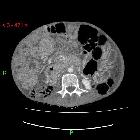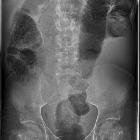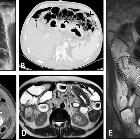Primary pneumatosis intestinalis
 ähnliche Suchen
ähnliche Suchen siehe auch
siehe auchPrimary pneumatosis intestinalis (PPI) is a benign idiopathic condition in which multiple gas-filled cystic lesions are seen in the gastrointestinal tract wall. The changes are usually seen initially on radiography or CT with CT being the more sensitive test.
Epidemiology
Primary pneumatosis intestinalis is rare and was shown in one study to comprise 15% of cases of all intestinal pneumatosis .
Clinical presentation
This condition is usually asymptomatic and presents as an incidental finding on medical imaging.
Pathology
Multiple gas-filled cysts are seen in the mucosa and submucosa of the small and large bowel.
Differential diagnosis
- ischemic bowel: gas in the ischemic bowel wall has a linear or bubble-like pattern, in contrast to the PPI gas pattern, which is circular
- causes of secondary pneumatosis intestinalis
- post-instrumentation of the bowel e.g. endoscopy, surgery
- COPD, ventilated patients
- drugs such as steroids, chemotherapy (e.g. bevacizumab)
- pseudopneumatosis: intraluminal gas trapped between feces and the bowel wall
See also
Siehe auch:
- Pneumatosis intestinalis
- Unterscheidung Pseudo-Pneumatosis intestinalis - echte Pneumatosis intestinalis
- pneumatosis intestinalis (mnemonic)
- Pneumatosis intestinalis bei Sklerodermie
- chronische Pneumatosis intestinalis bei HIV
- Pneumatosis intestinalis bei Methotrexat
- Pneumatosis intestinalis bei COPD
und weiter:
 Assoziationen und Differentialdiagnosen zu benigne Pneumatosis intestinalis:
Assoziationen und Differentialdiagnosen zu benigne Pneumatosis intestinalis:
















